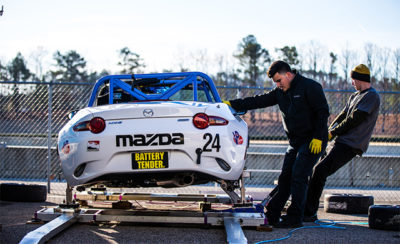In a series by Racers360, today we dive into the strategy of race car set up.
Once you have a strong driving foundation, you should start making set-up changes. Until then, focus your energy on driving and adapting your driving style to the balance of the car.
When you start off a race weekend, focus on optimal throttle application areas, brake pressure for trail braking and initial braking application pressures (see Driving Tip #4). Once your driving foundation is set, remember that the goal of getting a car set up is to make it as neutral as possible (in terms of balance of the car) to let us as drivers race the car in the most efficient way.
Because a race car’s balance is never perfect, we have to, in at least a small way, adjust our driving style to suit the balance of the car; however, since we want to drive it to the theoretically fastest way, we need to work on set up during practice sessions. The goal during practice is to get the car balance in a place where we need to make as few driving adjustments as possible due to an imbalance. Simply, set up the car to create the ideal balance rather than spend your time making driving adjustments to a poorly balanced car.
Focus the setup changes to positively affect the most important areas for time on the racetrack. Determine the top one or two areas that are slowing you down; work on setup changes to fix those issues.
Since a car that understeers or oversteers is not optimal and forces the driver to drive it in a way that is not the fastest, we try to eliminate those imbalances. There are times, however, that we won’t be able to, so we may want to set up the car to start with an imbalance, which may be intended to hedge a greater, different imbalance.
Engineering in Understeer or Oversteer
There are rare times that we want to engineer in a certain balance issue, but this is a pretty high-level technique and is something race car drivers should probably avoid doing until they have a lot of experience with a specific car, on the same set of tires, on a track they have run this combination at many times.
Every race weekend, you will learn about yourself and your car. Every car’s balance will go in different directions during a race depending on the track, tires, temperature, and more. After enough experience, you will know which direction the balance of the car will go throughout the race stint.
As you work on learning about these factors relative to your car and are better able to predict, with high confidence, how the balance will change, you can set up the car to start off the stint with a balance slightly in the opposite direction of where it will go during the stint.
The Simple, Must-Do Process
Before you work on car setup during the race weekend, know these two steps:
1) Ensure your driving foundations are in place before working on set up. If you start adjusting setup before you are done making your driving adjustments, most of that work will be trying to get the car to work while driving incorrectly. This means you will never find the optimum lap time in the car and it will be more difficult to fix your driving issues later as the car balance will feel worse as you drive it better.
2) Focus on one issue at a time. Think through the track and ask yourself, “What is the biggest issue that is preventing me from going faster?” If you have multiple issues to choose between, try to determine if the issues are related like in our example above. When you are ready to make a change, we often see on data that prioritizing fixing the issue that comes earlier in the corner pays the largest dividends.


 ACCESSIBILITY
ACCESSIBILITY